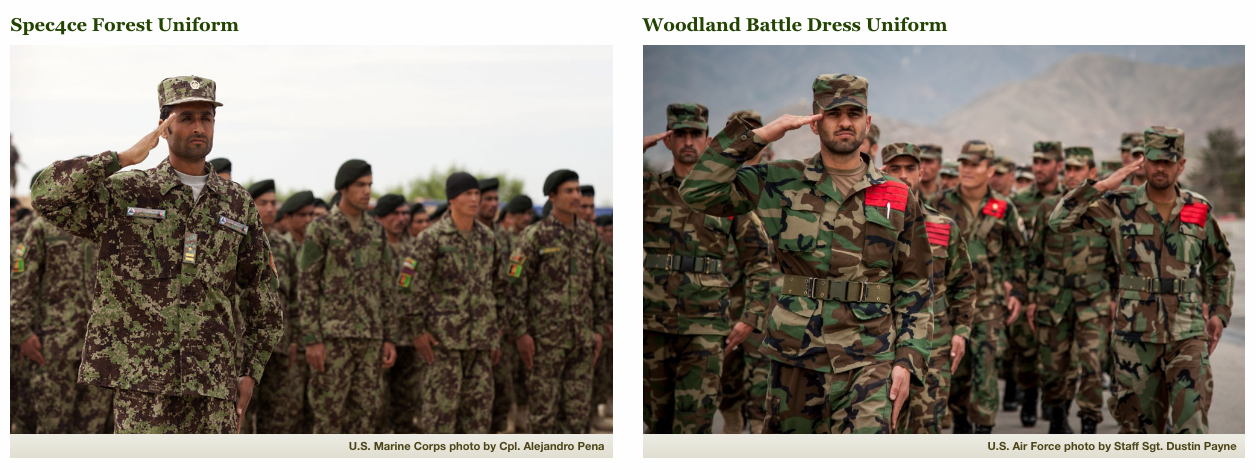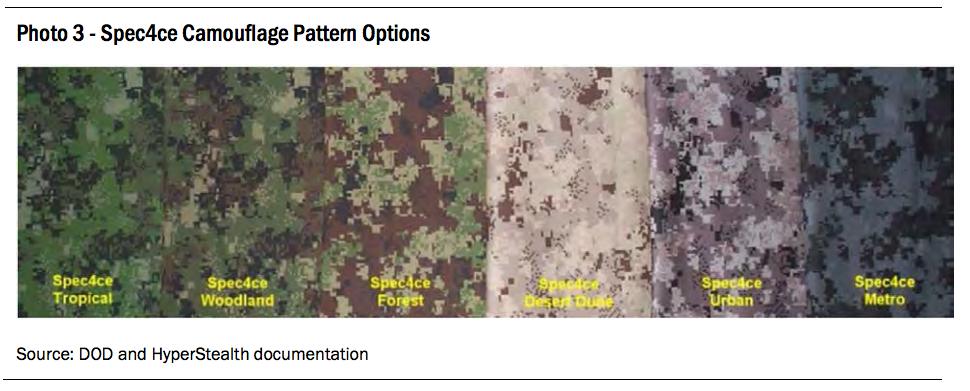The price tag for the never-ending, but occasionally paused, war in Afghanistan is well north of a trillion dollars by now. Nearly $US100 million ($132 million) of that is attributable to America’s generous decision to buy uniforms for the struggling Afghan National Army — and a newly released inspector general report says that as much as $US28 million ($37 million) of that cost was tacked on to pay for a proprietary camouflage pattern that Afghanistan’s then-minister of defence thought looked cool.
Spec4ce Forest camouflage image via Hyperstealth Biotechnology Corp
According to the report, the pattern — a green-and-brown forest scheme useless for concealment in the 97.9 per cent of Afghanistan’s landscape that isn’t forest — resulted in a 41 per cent increase in the cost of each uniform, purely for looks. Looks that may have made the soldiers more visible targets against urban and desert backgrounds.

Image via SIGAR. Guess which one costs $37 million more?
Moreover, according to the website of the camouflage vendor, two other Afghan forces are using two other proprietary camo patterns that the US military is presumably also footing the bill for.
The decision dates back to 2007, when the Afghan National Army decided to do something about the fact that its troops were wearing a “‘hodgepodge’ of donated uniforms with little standardisation,” according to the report from the Special Inspector General for Afghan Reconstruction (SIGAR). The mismatched gear was a problem in that it made it hard to tell friend from foe.
So the plan was to equip the whole army with the same uniform. Like anyone looking for new clothing, personnel from the US-led international military group for Afghanistan turned to the internet for help. There, they came across HyperStealth Biotechnology Corp., a company whose name seems to have tumbled out of a comic book (and which has, in fact, made uniforms for a Marvel movie, the bad Iron Man one).
Founded in 1999, the Canadian company started out around a plan to make “hyperbaric chambers and passive negative-ion generators for professional hockey players,” according to the Atlantic, but later pivoted to making copyrighted camouflage patterns, and maybe one day an invisibility cloak. Seriously. According to its website, it has worked with over 50 countries to develop camouflage patterns for their military and police forces, including a snow camo for the US Marine Corps and patterns for “US federal law enforcement [that it’s] unable to disclose”.
The dramatically-rendered report recounts how the group, in consultation with Afghanistan’s then-Minister of Defence Abdul Rahim Wardak, emailed the company to tell it “they ‘ran across [HyperStealth’s] web site and the Minister… liked what he saw’”. The patterns were pretty cool:

The Hyperstealth patterns that caught the Minister’s eye, via SIGAR.
So then, based on no testing of its appropriateness for Afghanistan’s landscape — 2.1 per cent of which is forest — the group decided the Afghan National Army’s new uniforms should be in the Spec4ce Forest camouflage, one of the copyrighted patterns offered by HyperStealth. That was despite the fact that the US military had lots of other (less cool) non-proprietary patterns they could have used instead for free:

Dull camouflage on offer for free
To be fair, the Afghan National Army had previously been using a woodland pattern, so apparently they liked the look. Nothing yells “we’re a real army” like a green, brown and tan camo.
When the Department of Defence made a contract for the uniforms in 2008, it required the copyrighted pattern be used, meaning the uniform vendor “would effectively be required to purchase pre-patterned material or obtain the rights to use the proprietary pattern from either HyperStealth or an authorised licensee,” according to the report.
The decision to go with the cool, if likely ineffective, forest camo wound up carrying a hefty price tag. According to SIGAR, the uniforms cost from $US26.65 million to $US28.23 million ($35.5 million to $37.4 million) more than they would have without the licensing fees for the proprietary pattern. A pair of pants and a shirt with a non-proprietary pattern for other Afghan military branches cost about $US56 ($74), while the army’s Spec4ce Forest uniforms cost $US79.14 ($105) each.
The report never explicitly says how much the patterns cost. “We are not disclosing the amount of the licensing fee to protect information that may be procurement sensitive and could influence other acquisitions,” reads a footnote.
But SIGAR suggests that the proprietary pattern be phased out, saying it will “save US taxpayers between $68.61 million and $72.21 million [$90.9 million to $95.7 million] over the next ten years”. When you consider the trillions of dollars the US has spent on the wars in Iraq and Afghanistan, that’s just budget dust, but it could mean a few more food stamps to go around.
The report does not address the fact that HyperStealth has licensed two other patterns to Afghan forces, including “Ghostex Kilo-1” to the Afghanistan Partner Unit and “Spec4ce Afghan Sierra” to the Afghanistan Civil Order Police.
A spokesperson for the Department of Defence pointed to a letter included with the SIGAR report as the Department’s official response. In that letter, Jedidiah Royal, the Acting Deputy Assistant Secretary of Defence for Afghanistan, Pakistan and Central Asia, wrote the DoD “should conduct a cost-benefit analysis” and acknowledged that there may have been a violation of federal rules that prohibit writing a contract that requires a particular brand name be used unless it is deemed essential after market research.
The spokesperson did not respond to a query about whether the US is also footing the bill for the two other proprietary patterns deployed in Afghanistan.
When asked about the report, HyperStealth’s CEO Guy Cramer, who has racked up many profiles over the years as the “Invisible Man“, sent us a link to a long rebuttal posted on SoldierSystems.net. It argues that part of the cost of the uniforms stems from their being made “in the USA from US materials”, not just from the proprietary pattern. The SIGAR report says the uniform materials were extremely similar but the rebuttal argues that the cheaper uniforms were a cotton-polyester-nylon blend while the more expensive uniforms are only cotton and nylon.
It also argues that the cool copyrighted forest pattern was essential because the Afghan National Army “wanted their pattern to be protected and not available to others, particularly their enemies”, who surely would be scared off by international copyright law.
“The pattern has been restricted from sale to anyone outside of the program,” reads the rebuttal from an unnamed author. “Afghan and American troops haven’t had to worry that an enemy infiltrator may have purchased a lookalike uniform online. I’m not sure how you can even put a price on that.”
You can. It’s about $37 million.
